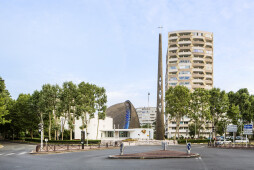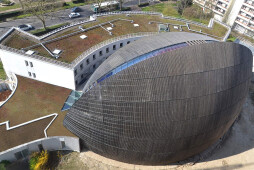In 2009, on the initiative of Bishop Santier, the diocesan association of Créteil, supported by the Chantiers du Cardinal, opted for an ambitious project to expand the cathedral of Notre- Dame de Créteil. Conceived by Charles-Gustave Stoskopf, holder of the Prix de Rome, this architecture is typical of the 1970s when “the theology of blending-in” prevailed at the time. It is part of the contemporary heritage of the City of Créteil. The commission was to double the capacity of the cathedral and to enhance its visibility towards the city. More than a renovation, this project involved a major redevelopment of the cathedral, giving it a new architectural lease on life from a symbolic and pastoral point of view. The new cathedral is anchored in a multicultural city, which includes five Catholic churches, ten synagogues, a mosque, a Protestant church, four Evangelical churches, a Buddhist temple and a Bahai assembly. A dialogue between two different architectural styles, yet consistent, is established. The dome pointing skywards is based on the footprint of the original cathedral. The silhouette of the entrance, on a human scale, is now joined with the monumental proportions of the new project, focusing on the nave of the cathedral that extends from two spherical wood-clad hulls, like two hands joined in prayer that meet above the altar. Large gatherings can be held in this new space.
The existing sanctuary has been remodeled and the benches are placed in a broad semicircle. In daylight, the stained-glass window located at the junction of the two hulls shed a colored light onto the sanctuary, while at night, illuminated from inside, they become the symbol of a living Christian community. The steeple, detached from the building on the corner of the forecourt, marks the cathedral entrance with its slender silhouette, punctuated by three bells from the old campanile. It restores the building urban scale and become a sign in the city beside the large residential buildings of the neighborhood. The view onto the cathedral forecourt is freed by opening the curtain of trees. The new square, built by the city on the opposite side, is an amenity for local residents, and an extension of parish life. 3































![[PACIFIC] Ocean Platform Prison - AC-CA [PACIFIC] Ocean Platform Prison - AC-CA](https://archello.com/thumbs/images/2014/04/04/r2out2-0.1506073088.7219.jpg?fit=crop&w=300&h=200&auto=compress)












